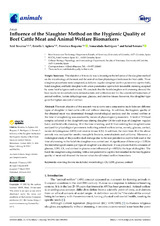Influence of the Slaughter Method on the Hygienic Quality of Beef Cattle Meat and Animal Welfare Biomarkers
Autor
Bouzraa, Said
Agüera, Estrella I.
Requena Domenech, Francisco
Rodríguez, Inmaculada
Serrano, Salud
Editor
MDPIFecha
2023Materia
StunningBovine meat
Halal
Microbiology
CK
LDH
Glucose
Cortisol
METS:
Mostrar el registro METSPREMIS:
Mostrar el registro PREMISMetadatos
Mostrar el registro completo del ítemResumen
The main objective of this research was to carry out a comparative study between different types of slaughter in beef cattle with and without stunning. In addition, the hygienic quality of the obtained meat was determined through microbiological analysis and the animal welfare at the time of slaughtering was assessed by means of physiological parameters. A total of 52 blood samples collected at the slaughterhouse during slaughter (10 for each type of slaughter: regular, halal, and halal with stunning; 10 at the time of resting; and 12 from rotating box slaughter) were analysed for physiological parameters indicating animal welfare status, namely, glucose, cortisol, lactate dehydrogenase (LDH) and creatine kinase (CK). In addition, the meat from 30 of the above animals was analysed for aerobic mesophilic bacteria, enterobacteria and coliforms. Moreover, a radiological study of the possible skull damage due to the non-penetrative captive bolt used at the time of stunning in the halal rite slaughter was carried out. A significance difference (p < 0.05) in the microbiological counts per type of slaughter was observed. It was proven that the amounts of glucose, LDH, CK, and cortisol in plasma were influenced (p < 0.05) by the type of slaughter. The halal rite slaughter using stunning with a non-penetrative captive bolt resulted in the best hygienic quality of meat and obtained the lowest values for all animal welfare biomarkers.

